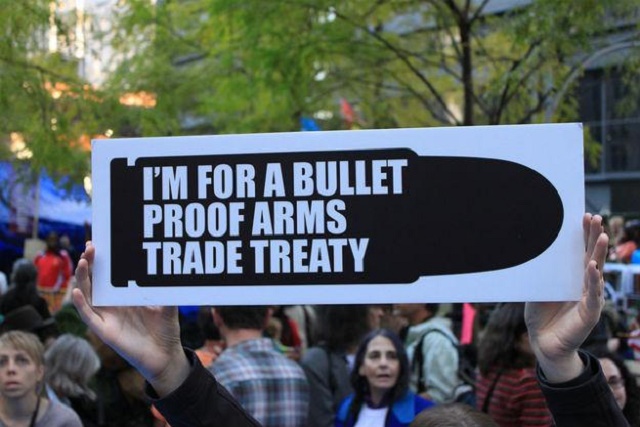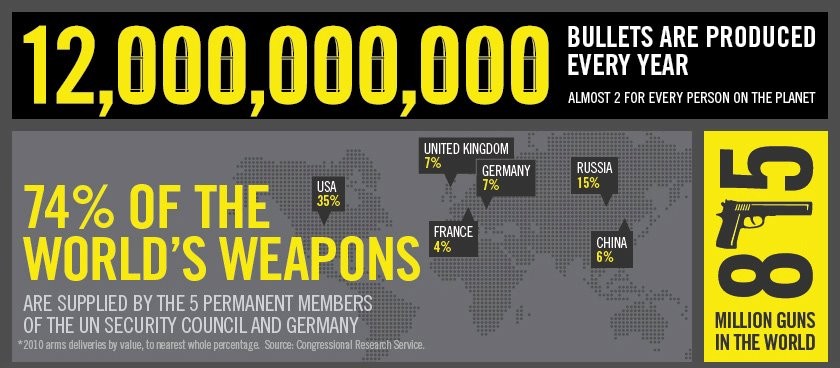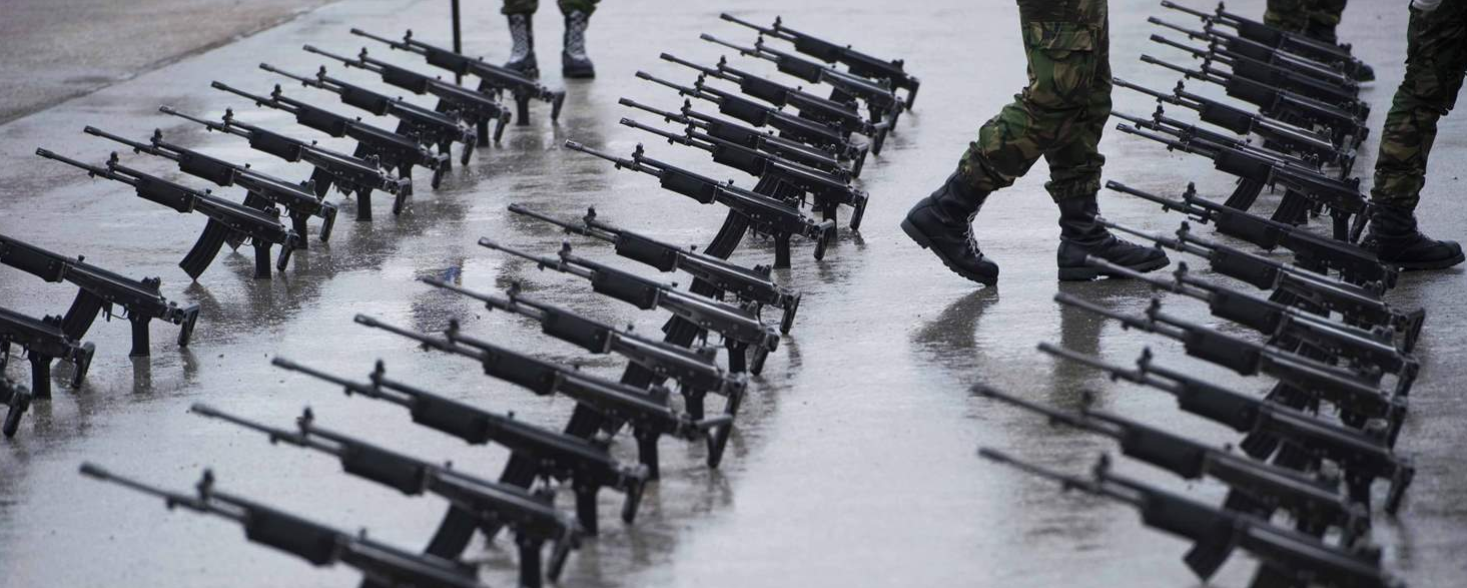
The Impact of US Arms Sales on
National and Global Security
Quincy Institute for Responsible Statecraft: Quincy Paper No. 9
Executive Summary
(October 20, 2023) — Following Saudi Arabia’s recent decision to cut oil production, a move that will raise prices in the West and is widely seen as a slight to the United States, two Democratic lawmakers have called for a freeze in all arms sales and military support to the Kingdom.1
For years, US politicians and commentators have claimed that American support for Saudi Arabia — which includes providing 70 percent of its weapons and technical support that its air force relies on to conduct its bombing campaign against Yemen — is necessary to ensure the Kingdom will provide stable energy supplies and side with the United States in geopolitical disputes. But the latest Saudi move has given the lie to these claims. It provides yet another urgent prompt to rethink US arms transfer policies to Saudi Arabia and, in fact, around the world.
The administration needs to address a number of key issues if US policy on arms sales is to be made consistent with long-term US interests. The key policy consideration is how to restrict sales to those that will help allies defend themselves without provoking arms races or increasing the prospects for conflict. Of particular note, the Australia-UK-US, or AUKUS submarine deal will benefit US contractors but risks fueling arms competition and increasing tensions with China.
Aid designed to help Ukraine defend itself from Russia has proceeded at the most rapid pace of any US military assistance program since at least the peak of the Vietnam War. But the United States has failed to offer an accompanying diplomatic strategy aimed at ending the war before it evolves into a long, grinding conflict or escalates into a direct US-Russian confrontation.
Finally, Washington needs to take steps to ensure that the financial interests of a handful of weapons contractors do not drive critical US arms export policy decisions.
Of the $101 billion in major arms offers since the Biden administration took office, over 58 percent involved weapons systems produced by four companies: Lockheed Martin, Boeing, Raytheon, and General Dynamics.
The concentrated lobbying power of these companies — including a “revolving door” from the Pentagon’s arms sales agency and the leveraging of weapons export-related jobs into political influence — has been brought to bear in efforts to expand US weapons exports to as many foreign clients as possible, often by helping to exaggerate threats.
A number of policy measures can be taken to increase the prospects that major sales will serve broader US interests in peace and stability in key countries and regions, rather than undermine them:
- Restricting the revolving door between government and industry as a way to weaken the grip of weapons makers over arms transfer decision making.
- Making it possible for Congress to block dangerous weapons sales, through a revision to the Arms Export Control Act that would require an affirmative congressional vote on major deals — as opposed to the current system, which requires a veto-proof majority to block any arms sale.
- Providing greater transparency so Congress and the public know what sales are being made, when arms are being delivered, and how US arms are being used. Without this level of information, it is virtually impossible for Congress or the public to fully assess the risks and consequences of US arms transfers.
- Requiring better risk assessments by the Pentagon and State Department as to the likely impact of particular sales regarding arms race dynamics, fueling conflict, enabling of human rights abuses, or diversion of US-supplied arms into the hands of US adversaries, and hiring sufficient staff to carry out these analyses.

Introduction
This paper assesses the security impacts of the Biden administration’s approach to foreign arms sales. It takes into account the policies of prior administrations and the longstanding role of the United States as the world’s leading arms exporting nation.
Issues addressed include the role of US arms transfers in fueling conflict, enabling human rights abuses, and entangling the United States in unnecessary conflicts. The paper focuses particularly on transfers to Europe and Asia, in line with the “great power” focus of US national security strategy; the security impacts of ongoing sales to the Middle East; and a discussion of the counterproductive effects of an overly militarized US approach to counterterrorism policy in North Africa and the Sahel.
The role of weapons contractors in shaping — and profiting from — US arms sales are also addressed, including the role of Raytheon in pressing for arms sales to Saudi Arabia despite its devastating use of US weapons in Yemen. The paper concludes with recommendations on how to improve US arms policy so that it aligns with the country’s security interests, in part by reforming the arms sales decision-making process.

The Biden Policy in Context
On arms sales, the Biden administration has shown more continuity than change relative to the policies of the prior two administrations. President Biden pledged during the 2020 presidential campaign that America would no longer “check its values at the door to sell arms.”2 In his first foreign policy speech he pledged to end US support for offensive operations in Yemen, as well as relevant arms sales.3
The administration also suspended sales to Saudi Arabia and the United Arab Emirates pending a policy review, but aside from blocking one proposed bomb sale to Riyadh, its policy quickly reverted to the status quo ante.
The Biden administration has continued to arm reckless, repressive regimes — like Saudi Arabia, the UAE, Egypt, Nigeria and the Philippines — that have acted in ways that undermine US interests and risk entangling the United States in unnecessary conflicts. The potential impacts of sales to each of these nations are outlined below.
In assessing any administration’s approach to arms transfers, it is important to note that the process of deciding on and supplying weapons can unfold over several years or more. This means that deals offered under one administration may have had their roots in a prior one. However, the specific offers to the countries cited above received final sign off during the Biden years, meaning that the administration can and should be held accountable for the potential impact of these sales.
The analysis of the impacts of arms sales is further complicated by the differences in the two main channels of arms supply — government-to-government sales under the Foreign Military Sales (FMS) program and Direct Commercial Sales (DCS) licensed by the State Department.
FMS offers give the US government more input into the terms of the deal and include follow-on support like arranging the provision of spare parts, but they also include a 3 percent administrative surcharge that some suppliers and recipients prefer to avoid.
Commercial sales involve direct negotiations between the supplying company and the recipient, offering the arms exporting firm more freedom to negotiate the price and to set the terms of supporting arrangements like co-production deals, which involve production of components of a weapons system in the recipient nation.4
SSOffers of major defense equipment under the FMS program are subject to detailed notifications to Congress that include the equipment offered, its anticipated dollar value, a brief description of its rationale, identification of the main contractors involved, and an indication of how many US personnel may be deployed to the recipient country in support of the sale.
By contrast, DCS authorizations are poorly and haphazardly reported. The weapons systems are described only as a part of broad categories, with no indication of which authorizations eventuate in final sales or deliveries to client nations. For most of the data included in this paper, the totals reflect only FMS deals. This channel includes most sales of major systems like military aircraft, armored vehicles, artillery, missiles, and combat ships.
US arms offers showed a sharp drop in the first year of the Biden administration, to $36 billion, down from $110.9 billion in the final year of the Trump administration.5
This drop may have been partly due to a less aggressive approach to arms sales promotion, but was more likely the consequence of market saturation caused by the huge volume of deals concluded during the Obama and Trump administrations. Offers have shown a major uptick in 2022, to $65 billion as of October.6 This is due in part to increases in sales to Europe and Asia tied to the Pentagon’s focus on “great power competition” with Russia and China.
The administration’s approach to arms sales going forward might be clarified once it releases its long-delayed policy directive on the issue. At a minimum, the release of the document will offer an opportunity for additional congressional and public debate regarding the consequences of US weapons exports and what criteria should be used in deciding which nations to arm.
The US Role in rhe Global Arms Trade
The United States accounted for 39 percent of major weapons deliveries for the five-year period from 2017–21, according to figures compiled by the Stockholm International Peace Research Institute (SIPRI). This is twice as large as Russia’s share of the market, and over eight times China’s share.7
Arms sales can also pose risks to US security by fueling conflicts, provoking US adversaries, stoking arms races, and drawing the US into unnecessary or counterproductive wars.
Advocates of weapons exports promote sales by claiming they help US allies provide for their own defense, stabilize key regions, deter US adversaries, build US military-to-military relationships with current and potential partner nations, provide political and diplomatic influence, and create jobs in the United States. But arms sales can also pose risks to US security by fueling conflicts, provoking US adversaries, stoking arms races, and drawing the US into unnecessary or counterproductive wars.
US sales can also enable human rights abuses by partner nations; these often provoke a backlash and increase the ability of terrorist groups to recruit. Too often, arms sales decisions are driven as much or more by the parochial interests of defense contractors as they are by security considerations.
Current US arms policy and practice too often fuel war rather than deterring it. Roughly two-thirds of current conflicts — 34 out of 46 — involve one or more parties armed by the United States.8 In some cases US arms sales to combatants in these wars are modest, while in others they play a major role in fueling and sustaining the conflict.
Of the US-supplied nations at war, 15 received $50 million or more worth of US arms between 2017 and 2021. This contradicts the longstanding argument that US arms routinely promote stability and deter conflict. While some US transfers are used for legitimate defensive purposes, others exacerbate conflicts, increase tensions, and fuel regional arms races.
There is a pronounced lack of transparency about the role of US arms in many of these wars, but the fact that US weapons are going to so many conflict zones is a concern in its own right, and demands better tracking of the precise role of US-supplied equipment.
Table 1: Countries at War that Received $50 Million
or More of US Weapons between 2017 and 2021
| Country | Type of Conflict | Value of Arms Supplied (USD) |
| Afghanistan | Major War | $9.1 billion |
| Brazil | High Intensity | $221.9 million |
| Colombia | High Intensity | $232.8 million |
| Egypt | High Intensity | $3.7 billion |
| Israel | Low Intensity | $7.1 billion |
| Kenya | High Intensity | $168.3 million |
| Lebanon | High Intensity | $500.5 million |
| Mexico | Low Intensity | $90.5 million |
| Nigeria | Low Intensity | $503.9 million |
| Philippines | Low Intensity | $521.9 million |
| Saudi Arabia* | Major War | $34.5 billion |
| Thailand | Low Intensity | $753.7 million |
| Turkey | High Intensity | $724 million |
| UAE* | Major War | $9 billion |
| Ukraine** | High Intensity | $1.6 billion |
* Parties to war in Yemen | ** Figures prior to February 2022 Russian invasion of Ukraine | SOURCES: Stockholm International Peace Research Institute, SIPRI Yearbook 2022, chapter 2; Armed Conflict Location and Event Data Project; and US Department of Defense, Defense Security Cooperation Agency. Conflict intensity is defined as follows: major war, 10,000 or more fatalities in a year; high intensity war, 1,000 to 9,999 fatalities in a year; low intensity war, 25 to 999 fatalities in a year.
Read the full report online at https://quincyinst.org/report/promoting-stability-or-fueling-conflict-the-impact-of-u-s-arms-sales-on-national-and-global-security/

